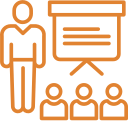Three examples of workplace challenges
Three different people, three different situations. Think about how each one’s response to their respective challenge demonstrates signs of workplace resilience. And that resiliency can be the key to long-term employee-, team, and organizational-level success.
- Drew is meeting with their team to readjust assignments after losing an employee who was critical to a major project.
- After reflecting on her unsuccessful attempt a few months prior and taking constructive feedback to heart, Janelle just clinched a lucrative contract for her small start-up.
- Ben’s company is navigating surprisingly well through the busiest season of the year, even with a few fewer hands than they would normally have on deck.
What is workplace resilience?
Simply put, resiliency is being able to bounce back from trying numerous times, often with a renewed sense of empowerment on the other end. More than that, resilience is a dynamic concept with several different types and the scope to affect systems at multiple levels.
Below are different areas where people, teams, and organizations can exhibit high or low resilience:
- Physical resilience allows you to have the stamina and means to push past physical limitations to produce results.
- Mental resilience relies on creativity and problem-solving to address challenges.
- Social resilience taps into networks, support systems, and other relationships to craft a strategy to respond to challenges.
- Emotional resilience helps to manage stress effectively and healthily.
Areas of workplace resilience
Thinking about each of these areas of resilience, you can begin to see how intertwined not only the concept of resilience is to one’s job but also how one’s resilience can help or hurt the broader organization. Someone with a customer-facing role, for example, might require a bit more social-emotional resilience. Compare that to that need to that of an award-winning athlete, who might err more on the side of higher physical and mental resilience. Knowing the levels of resilience and in what areas resilience may be dominant or lacking can help ensure a workplace wherein people, departments, and teams are working together to balance and support resiliency in all areas.
Five signs of workplace resilience
So, what does that look like? There are just as many signs of workplace resilience (or a lack thereof) as there are opportunities for employees and teams to demonstrate it.
Here are five top signs of workplace resilience.
1. Strong personal and professional networks. Employees come to work feeling supported and motivated from bother their personal and professional relationships. These are sources of connection, not stress. Workplace support networks not only offer room for advancement, they contribute to an employee’s overall learning and development, provide room for coaching and mentoring, and lend to a more positive culture.
2. Positive culture. The culture of an organization is the biggest boon or bust for workplace resilience. For top-down structures especially, the degree to which culture can contribute to growing or diminishing resiliency ties directly back to leadership. Workplace culture should be welcoming from the start of onboarding throughout that employee’s entire career. The culture should practice and promote inclusivity, thereby helping employees at every level feel like valued team members. Moreover, positive and robust cultures encourage continuous learning and promote accountability so that mistakes are acknowledged and teams can take advantage of the lessons that come from them.
3. Adapting to (and mastering) change. One of the most noticeable signs of resiliency in the workplace is the ability to adapt to change. Teams and organizations that can work through the kinks of resistance and hesitancy, prepare as much as possible, maintain solid communication, and adapt at a moment’s notice are among the most resilient. These teams are able to produce through uncertainty, learn to thrive, and extend career and organizational longevity.
4. High collaboration. Collaborative workplaces are hubs for creative problem-solving. People coming together across teams or departments to work on a problem bring along with them various perspectives, insights, experiences, and energy that could spark wildly creative solutions. Furthermore, they help to forge bonds, facilitating partnership and support.
5. Maintain control. At every level, from frontline staff to senior leadership, it is imperative that one can maintain control of themselves before, during, and after a stressful situation. Stress management, a balanced approach to work, and self-care are all key to juggling demands. Does your workplace offer a wellness program? Are mental health days provided? Do you feel as if you can safely debrief a stressful situation without facing mistreatment or borderline abuse? If your workplace is without avenues to develop emotional resilience and overall well-being, chances are there is resiliency-building work to be done.
Workplace resilience
A resilient workplace supports its employees, is able to adapt, and can effectively utilize strengths to address challenges. In order for a workplace to be resilient, resiliency needs to be developed at the individual, team, and organizational levels. There are ways to build resilience and make it inherent to day-to-day communications and operations. The stories of Drew, Janelle, and Ben illustrate that resilience is not a one-size-fits-all concept; it manifests differently in various aspects of our professional lives. Recognizing the multifaceted nature of resilience can be the first step toward creating a workplace where individuals, teams, and entire organizations thrive. By nurturing strong networks, fostering a positive culture, embracing change, promoting collaboration, and prioritizing well-being, we can lay the foundation for a resilient workplace that not only weathers the storms but emerges stronger and more agile than ever before. As we continue our journey in the dynamic world of work, let us remember that resilience is not just a trait to be admired; it’s a skill to be cultivated and integrated into our daily operations, paving the way for a brighter and more resilient future.
















